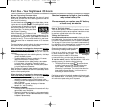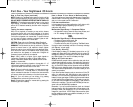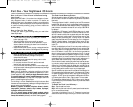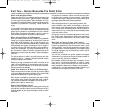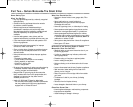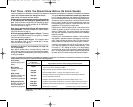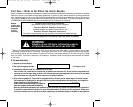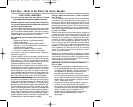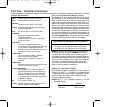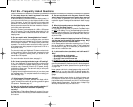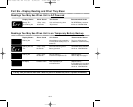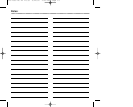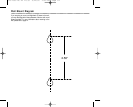
Part Four – What to Do When the Alarm Sounds
Remember to determine if anyone is at high risk for CO poisoning.
If so, you should use precaution not to expose the at-risk person to
low levels for more than eight hours.
If no one is experiencing symptoms of CO poisoning, press the reset
button on the alarm. Under normal operation, the alarm will not dis-
play CO concentrations detected between 1 and 29 ppm. By pressing
the peak level button, you can see if any concentration from 11 to 999
has been detected including low levels of 11 to 29 ppm.
Then, consider whether the following could be sources of the low
CO levels:
• Cigarette smoke? Gas oven or range? Attached garage?
Fuel-burning appliances?
• Has anyone used chemicals that could affect the sensor?
(See page 1-7 or a list of chemicals that can have a temporary
or permanent affect on the sensor.)
• Has there been a temperature inversion in the area?
• Do you live in an area with air pollution or heavy traffic?
Test the alarm to verify that it is working properly, following the
instructions on page 1-5, 6.
If the alarm appears to be functioning properly, ventilate your home
and turn fuel-burning appliances to the “off” position until the digital
display returns to “0.” Then, turn appliances back on and take note
of any further readings at one hour intervals. Note if the turning on of
appliances has caused any change in CO alarm readings.
Sometimes conditions may develop that are not caused by malfunc-
tioning appliances or structural problems that need to be repaired.
These conditions can create a temporary build-up of low CO levels
that will dissipate and may not return. (For example: weather condi-
tions or backdrafts caused by differences in air pressure between the
inside and outside of the home). This is why we suggest you venti-
late the home and then monitor to see if any CO levels reappear.
Treatment for CO Poisoning
Any person who is suspected to have carbon monoxide poisoning
should leave the potentially dangerous environment, get fresh air
immediately and seek care from a physician. CO poisoning can be
determined by a simple blood test, called a “carboxyhemoglobin” test.
This test measures the amount of carbon monoxide in the blood-
stream. For this test to be accurate, it must be done immediately after
CO exposure. Acute CO poisoning is usually treated by breathing in
oxygen. When CO poisoning is severe, (for example, when there is
an altered state of consciousness), high pressure oxygen therapy in
a special “hyperbaric chamber” may be used. A physician will make
this determination and administer treatment if necessary.
Calling a Qualified Technician to Find and Repair
the Problem
If you call a qualified service technician (such as a licensed heat-
ing contractor, utility service technician, chimney sweep or fuel
provider) to inspect your home for possible sources of CO, tell
the technician what the digital readings were and have them
press the peak level memory button. This way they can see how
big a problem they are dealing with. Do not restart these appli-
ances until the problem is corrected. Request service for as soon
as possible, like TODAY.
Please be aware that some service technicians may charge a fee
to inspect your home, even if the source of CO is not found. You
may wish to find out if you will be charged for the service and
the amount of the fee before you request service. Some public
utilities do not charge for inspection. Some service technicians
do not charge if you purchased your appliance from them. To
know for sure, you need to ask before the technician comes to
your home. Repair work or replacement of appliances may be
necessary to fix the problem that is creating the CO in your
home. Remember, a CO alarm can only warn you of the pres-
ence of CO, it does not prevent CO from occurring, nor can it
solve an existing CO problem.
Because you’ve provided ventilation by leaving your windows
and doors open, the CO buildup may have dissipated by the time
help responds. Although your problem may appear to be tem-
porarily solved, it’s crucial that the source of the CO is deter-
mined and appropriate repairs are made.
Sometimes it’s Difficult to Find the Source of
CO in a Home
It can be difficult for responders to locate the source(s) of CO if:
• The house was ventilated before they arrived and the fresh
air caused the CO to dissipate. The peak level function on
your Nighthawk CO alarm helps the responders know
how severe the problem was before they arrived.
• The CO problem was caused by a source that fluctuates on
and off, sometimes creating CO and sometimes not. Such a
situation makes it nearly impossible to pinpoint the source
of CO in a short period of time.
• The cause of CO problem was backdrafting – when air in
a chimney or flue is sucked into the home instead of
venting outside. The exact situation that created a negative
air pressure inside the home (the cause of backdrafting) is
difficult to recreate during an investigation for CO.
Sometimes the CO problem disappears when a door or
window is opened. Backdrafting may or may not
happen again.
LOW LEVEL READING,
Unit will not alarm when Peak Level Button is Pressed
Unit reads below 50 ppm of carbon monoxide.
4-2
810-1368 AC PP 12/99 8/24/00 2:06 PM Page 17




